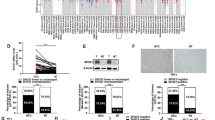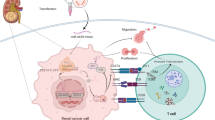Abstract
Hepatocellular carcinoma (HCC) is the most common primary liver malignancy. Uncontrolled angiogenesis plays a critical role in hepatocellular tumor growth and metastasis. In this study, we aimed to investigate the effects of circular RNA hsa_circ_0000519 and the potential involvement of microRNA (miR)-1296 and E2F transcription factor 7 (E2F7) in HCC development. Hsa_circ_0000519 was highly expressed in HCC cells and hepatocellular tumor tissues, and correlated with poor prognosis of HCC patients. Knockdown of hsa_circ_0000519 significantly reduced HCC cell viability, suppressed cell proliferation, and induced cell cycle arrest in G0/G1. Downregulation of hsa_circ_0000519 also inhibited formation of capillary-like endothelial structures in vitro and impeded microvessel formation in mice bearing HCC tumors. The migration and invasive capacities of HCC cells were markedly reduced by hsa_circ_0000519 knockdown. Hsa_circ_0000519 possessed a binding site for microRNA (miR)-1296. Upregulation of hsa_circ_0000519 significantly decreased the miR-1296 expression in both HCC cells and mouse xenografts. Furthermore, E2F7 was a target of miR-1296. Hsa_circ_0000519 positively regulated E2F7 via acting as a miR-1296 sponge. Upregulation of E2F7 abolished the inhibitory effects of hsa_circ_0000519 knockdown on HCC cell proliferation and angiogenesis. In conclusion, hsa_circ_0000519 promoted tumor progression and angiogenesis in HCC through the miR-1296/E2F7 axis. These data suggest the potential clinical application of hsa_circ_0000519 in HCC treatment.







Similar content being viewed by others
Data availability
All data generated or analyzed during this study are included in this published article.
References
Frager SZ, Schwartz JM. Hepatocellular carcinoma: epidemiology, screening, and assessment of hepatic reserve. Curr Oncol (Toronto, Ont). 2020;27(Suppl 3):S138–43. https://doi.org/10.3747/co.27.7181.
Bray F, Ferlay J, Soerjomataram I, Siegel RL, Torre LA, Jemal A. Global cancer statistics 2018: GLOBOCAN estimates of incidence and mortality worldwide for 36 cancers in 185 countries. CA. 2018;68(6):394–424. https://doi.org/10.3322/caac.21492.
Ziyad S, Iruela-Arispe ML. Molecular mechanisms of tumor angiogenesis. Genes Cancer. 2011;2(12):1085–96. https://doi.org/10.1177/1947601911432334.
Moawad AW, Szklaruk J, Lall C, Blair KJ, Kaseb AO, Kamath A, et al. Angiogenesis in hepatocellular carcinoma; pathophysiology, targeted therapy, and role of imaging. J Hepatocell Carcinoma. 2020;7:77–89. https://doi.org/10.2147/jhc.s224471.
Huang Z, Zhou JK, Peng Y, He W, Huang C. The role of long noncoding RNAs in hepatocellular carcinoma. Mol Cancer. 2020;19(1):77. https://doi.org/10.1186/s12943-020-01188-4.
Chen LL, Yang L. Regulation of circRNA biogenesis. RNA Biol. 2015;12(4):381–8. https://doi.org/10.1080/15476286.2015.1020271.
Ng WL, Mohd Mohidin TB, Shukla K. Functional role of circular RNAs in cancer development and progression. RNA Biol. 2018;15(8):995–1005. https://doi.org/10.1080/15476286.2018.1486659.
Jia B, Yin X, Wang Y, Qian J, He Y, Yang C, et al. CircRNA-PTN sponges miR-326 to promote proliferation in hepatocellular carcinoma. Onco Targets Ther. 2020;13:4893–903. https://doi.org/10.2147/ott.s251300.
Wang YG, Wang T, Ding M, Xiang SH, Shi M, Zhai B. hsa_circ_0091570 acts as a ceRNA to suppress hepatocellular cancer progression by sponging hsa-miR-1307. Cancer Lett. 2019;460:128–38. https://doi.org/10.1016/j.canlet.2019.06.007.
Zhang Z, Li H, Zhao Y, Guo Q, Yu Y, Zhu S, et al. Asporin promotes cell proliferation via interacting with PSMD2 in gastric cancer. Front Biosci (Landmark edition). 2019;24:1178–89.
Morishita A, Oura K, Tadokoro T, Fujita K, Tani J, Masaki T. MicroRNAs in the pathogenesis of hepatocellular carcinoma: a review. Cancers. 2021. https://doi.org/10.3390/cancers13030514.
Xu Q, Liu X, Liu Z, Zhou Z, Wang Y, Tu J, et al. MicroRNA-1296 inhibits metastasis and epithelial-mesenchymal transition of hepatocellular carcinoma by targeting SRPK1-mediated PI3K/AKT pathway. Mol Cancer. 2017;16(1):103. https://doi.org/10.1186/s12943-017-0675-y.
Chen HZ, Tsai SY, Leone G. Emerging roles of E2Fs in cancer: an exit from cell cycle control. Nat Rev Cancer. 2009;9(11):785–97. https://doi.org/10.1038/nrc2696.
Kent LN, Leone G. The broken cycle: E2F dysfunction in cancer. Nat Rev Cancer. 2019;19(6):326–38. https://doi.org/10.1038/s41568-019-0143-7.
Ma YS, Lv ZW, Yu F, Chang ZY, Cong XL, Zhong XM, et al. MicroRNA-302a/d inhibits the self-renewal capability and cell cycle entry of liver cancer stem cells by targeting the E2F7/AKT axis. J Exp Clin Cancer Res. 2018;37(1):252. https://doi.org/10.1186/s13046-018-0927-8.
Teng F, Zhang JX, Chang QM, Wu XB, Tang WG, Wang JF, et al. LncRNA MYLK-AS1 facilitates tumor progression and angiogenesis by targeting miR-424-5p/E2F7 axis and activating VEGFR-2 signaling pathway in hepatocellular carcinoma. J Exp Clin Cancer Res. 2020;39(1):235. https://doi.org/10.1186/s13046-020-01739-z.
World Medical Association Declaration of Helsinki. ethical principles for medical research involving human subjects. JAMA. 2013;310(20):2191–4. https://doi.org/10.1001/jama.2013.281053.
Suzuki H, Zuo Y, Wang J, Zhang MQ, Malhotra A, Mayeda A. Characterization of RNase R-digested cellular RNA source that consists of lariat and circular RNAs from pre-mRNA splicing. Nucleic Acids Res. 2006;34(8):e63. https://doi.org/10.1093/nar/gkl151.
Jeck WR, Sorrentino JA, Wang K, Slevin MK, Burd CE, Liu J, et al. Circular RNAs are abundant, conserved, and associated with ALU repeats. RNA (New York, NY). 2013;19(2):141–57. https://doi.org/10.1261/rna.035667.112.
Zirkel A, Papantonis A. Detecting circular RNAs by RNA fluorescence in situ hybridization. Methods Mol Biol (Clifton, NJ). 2018;1724:69–75. https://doi.org/10.1007/978-1-4939-7562-4_6.
National Research Council Committee for the Update of the Guide for the C, Use of Laboratory A. The national academies collection: reports funded by national institutes of health. In: Guide for the care and use of laboratory animals. Washington: National Academies Press (US) National Academy of Sciences; 2011.
Palomero J, Vegliante MC, Rodríguez ML, Eguileor A, Castellano G, Planas-Rigol E, et al. SOX11 promotes tumor angiogenesis through transcriptional regulation of PDGFA in mantle cell lymphoma. Blood. 2014;124(14):2235–47. https://doi.org/10.1182/blood-2014-04-569566.
Brar G, Greten TF, Graubard BI, McNeel TS, Petrick JL, McGlynn KA, et al. Hepatocellular carcinoma survival by etiology: a SEER-medicare database analysis. Hepatol Commun. 2020;4(10):1541–51. https://doi.org/10.1002/hep4.1564.
Zhang Y, Wang Y. Circular RNAs in hepatocellular carcinoma: emerging functions to clinical significances. Front Oncol. 2021;11:667428. https://doi.org/10.3389/fonc.2021.667428.
Iparraguirre L, Muñoz-Culla M, Prada-Luengo I, Castillo-Triviño T, Olascoaga J, Otaegui D. Circular RNA profiling reveals that circular RNAs from ANXA2 can be used as new biomarkers for multiple sclerosis. Hum Mol Genet. 2017;26(18):3564–72. https://doi.org/10.1093/hmg/ddx243.
Liang L, Zhang L, Zhang J, Bai S, Fu H. Identification of circRNA-miRNA-mRNA networks for exploring the fundamental mechanism in lung adenocarcinoma. Onco Targets Ther. 2020;13:2945–55. https://doi.org/10.2147/ott.s235664.
Otto T, Sicinski P. Cell cycle proteins as promising targets in cancer therapy. Nat Rev Cancer. 2017;17(2):93–115. https://doi.org/10.1038/nrc.2016.138.
Bisteau X, Caldez MJ, Kaldis P. The complex relationship between liver cancer and the cell cycle: a story of multiple regulations. Cancers. 2014;6(1):79–111. https://doi.org/10.3390/cancers6010079.
Morse MA, Sun W, Kim R, He AR, Abada PB, Mynderse M, et al. The role of angiogenesis in hepatocellular carcinoma. Clini Cancer Res. 2019;25(3):912–20. https://doi.org/10.1158/1078-0432.ccr-18-1254.
Haibe Y, Kreidieh M, El Hajj H, Khalifeh I, Mukherji D, Temraz S, et al. Resistance mechanisms to anti-angiogenic therapies in cancer. Front Oncol. 2020;10:221. https://doi.org/10.3389/fonc.2020.00221.
Phan B, Majid S, Ursu S, de Semir D, Nosrati M, Bezrookove V, et al. Tumor suppressor role of microRNA-1296 in triple-negative breast cancer. Oncotarget. 2016;7(15):19519–30. https://doi.org/10.18632/oncotarget.6961.
Shan X, Wen W, Zhu D, Yan T, Cheng W, Huang Z, et al. miR 1296–5p inhibits the migration and invasion of gastric cancer cells by repressing ERBB2 expression. PloS One. 2017;12(1):e0170298. https://doi.org/10.1371/journal.pone.0170298.
Bobowicz M, Skrzypski M, Czapiewski P, Marczyk M, Maciejewska A, Jankowski M, et al. Prognostic value of 5-microRNA based signature in T2–T3N0 colon cancer. Clin Exp Metas. 2016;33(8):765–73. https://doi.org/10.1007/s10585-016-9810-1.
Zong S, Liu X, Zhou N, Yue Y. E2F7, EREG, miR-451a and miR-106b-5p are associated with the cervical cancer development. Arch Gynecol Obstet. 2019;299(4):1089–98. https://doi.org/10.1007/s00404-018-5007-y.
Wang Y, Pei X, Xu P, Tan Z, Zhu Z, Zhang G, et al. E2F7, regulated by miR-30c, inhibits apoptosis and promotes cell cycle of prostate cancer cells. Oncol Rep. 2020;44(3):849–62. https://doi.org/10.3892/or.2020.7659.
Liang R, Xiao G, Wang M, Li X, Li Y, Hui Z, et al. SNHG6 functions as a competing endogenous RNA to regulate E2F7 expression by sponging miR-26a-5p in lung adenocarcinoma. Biomed Pharmacother. 2018;107:1434–46. https://doi.org/10.1016/j.biopha.2018.08.099.
Lu T, Wang R, Cai H, Cui Y. Long non-coding RNA DLEU2 promotes the progression of esophageal cancer through miR-30e-5p/E2F7 axis. Biomed Pharmacother. 2020;123:109650. https://doi.org/10.1016/j.biopha.2019.109650.
Thurlings I, Martínez-López LM, Westendorp B, Zijp M, Kuiper R, Tooten P, et al. Synergistic functions of E2F7 and E2F8 are critical to suppress stress-induced skin cancer. Oncogene. 2017;36(6):829–39. https://doi.org/10.1038/onc.2016.251.
Ling S, Zhan Q, Jiang G, Shan Q, Yin L, Wang R, et al. E2F7 promotes mammalian target of rapamycin inhibitor resistance in hepatocellular carcinoma after liver transplantation. Am J Transplant. 2022;22(10):2323–36. https://doi.org/10.1111/ajt.17124.
Moreno E, Toussaint MJM, van Essen SC, Bongiovanni L, van Liere EA, Koster MH, et al. E2F7 Is a potent inhibitor of liver tumor growth in adult mice. Hepatol (Baltimore, MD). 2021;73(1):303–17. https://doi.org/10.1002/hep.31259.
Funding
This work was supported by the National Natural Science Foundation of China (Grant No. 81801990).
Author information
Authors and Affiliations
Contributions
YL and HT designed the study, supervised the data collection, YZ and QW analyzed the data, interpreted the data, SL, ZW and XS prepared the manuscript for publication and reviewed the draft of the manuscript. All authors have read and approved the manuscript.
Corresponding author
Ethics declarations
Conflict of interest
The authors state that there are no conflicts of interest to disclose.
Ethical approval
All procedures performed in studies involving human participants were in accordance with the standards upheld by the Ethics Committee of the Second Affiliated Hospital of Chongqing Medical University and with those of the 1964 Helsinki Declaration and its later amendments for ethical research involving human subjects Approval number: 2015 (53). All animal experiments were approved by the Ethics Committee of the Second Affiliated Hospital of Chongqing Medical University for the use of animals and conducted in accordance with the National Institutes of Health Laboratory Animal Care and Use Guidelines Approval number: 2021 (195).
Informed consent
Written informed consent was obtained from a legally authorized representative(s) for anonymized patient information to be published in this article.
Additional information
Publisher's Note
Springer Nature remains neutral with regard to jurisdictional claims in published maps and institutional affiliations.
Supplementary Information
Below is the link to the electronic supplementary material.
Rights and permissions
Springer Nature or its licensor (e.g. a society or other partner) holds exclusive rights to this article under a publishing agreement with the author(s) or other rightsholder(s); author self-archiving of the accepted manuscript version of this article is solely governed by the terms of such publishing agreement and applicable law.
About this article
Cite this article
Liu, Y., Tang, H., Zhang, Y. et al. Circular RNA hsa_circ_0000519 contributes to angiogenesis and tumor progression in hepatocellular carcinoma through the miR-1296/E2F7 axis. Human Cell 36, 738–751 (2023). https://doi.org/10.1007/s13577-022-00854-7
Received:
Accepted:
Published:
Issue Date:
DOI: https://doi.org/10.1007/s13577-022-00854-7




